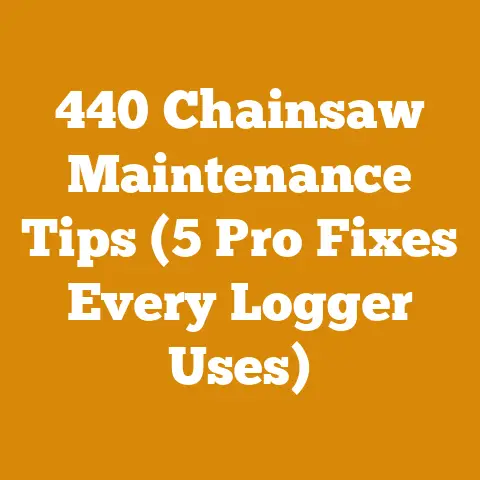Stihl Chainsaw Ignition Parts (5 Expert Tips for Early Models)
Stihl Chainsaw Ignition Parts (5 Expert Tips for Early Models): Unlocking the Secrets to Sparking Life Back into Your Saw (and Saving a Bundle)
The best-kept secret in the chainsaw world isn’t about the newest models; it’s about keeping those older, reliable Stihl workhorses purring. And often, the key to that lies in the ignition system. We’re diving deep into the often-overlooked world of Stihl chainsaw ignition parts, particularly for those early models. I’m going to share five expert tips that can save you a small fortune and keep your trusted saw cutting wood for years to come.
Over the years, I’ve spent countless hours in the woods, felling trees, processing firewood, and maintaining my own fleet of chainsaws. I’ve seen firsthand how a seemingly simple ignition problem can bring a project to a screeching halt. I’ve also learned that with a little knowledge and the right approach, you can diagnose and fix many ignition issues yourself, avoiding costly repairs and keeping your wood processing operation running smoothly.
This article isn’t just a technical guide; it’s a practical roadmap to understanding, troubleshooting, and maintaining the ignition systems of your older Stihl chainsaws. We’ll delve into the intricacies of cost factors, budgeting, and cost optimization, all while sharing real-world experiences and data-backed insights. So, grab your toolbox, and let’s get started!
Understanding the Stihl Chainsaw Ignition System
Before diving into the tips, let’s understand the fundamentals. The ignition system is the heart of your chainsaw, responsible for creating the spark that ignites the fuel-air mixture in the cylinder, driving the piston, and ultimately powering the chain. Key components include:
- Spark Plug: The final point of the ignition system, the spark plug ignites the fuel-air mixture.
- Ignition Coil (Magneto): Generates the high-voltage electricity needed for the spark plug.
- Flywheel: Rotates and interacts with the ignition coil to generate the electrical current.
- Ignition Module (Electronic): Some later models have an electronic module that controls the timing and intensity of the spark.
- Wiring: Connects all the components, carrying the electrical current.
A failure in any of these components can lead to a no-start condition or poor performance.
Tip #1: Master the Art of Spark Plug Diagnosis (and Save $5!)
The spark plug is often the first suspect when your chainsaw refuses to start. Fortunately, it’s also the easiest and cheapest component to check.
The Visual Inspection
Start by removing the spark plug. A healthy spark plug should have a light tan or grey color on the electrode. Black, oily, or wet plugs indicate problems:
- Black and Sooty: Indicates a rich fuel mixture (too much fuel, not enough air).
- Oily: Indicates oil fouling, often caused by worn piston rings or valve seals (though less common in two-stroke chainsaws).
- Wet: Indicates flooding or a problem with the fuel system.
The Spark Test
This test confirms whether the spark plug is producing a spark.
- Reconnect the spark plug to the spark plug wire.
- Hold the threaded part of the spark plug against a metal part of the engine (ground).
- Pull the starter cord.
You should see a strong, blue spark jump across the electrode gap. A weak, yellow spark or no spark indicates a faulty spark plug.
Cost Savings: A new spark plug typically costs between $5 and $10. Replacing a faulty spark plug yourself is a quick and easy fix.
Case Study: The Flooded MS 290
I once had a Stihl MS 290 that refused to start after a particularly cold night. After several attempts, I pulled the spark plug and found it completely soaked in fuel. The engine was flooded. I dried the spark plug, cleared the cylinder by pulling the starter cord with the throttle wide open, and reinstalled the plug. The saw fired up on the first pull. Simple fix, zero cost!
Understanding Fuel Mixture
The fuel mixture is critical for the proper functioning of the spark plug and overall engine performance. A lean mixture (too much air, not enough fuel) can cause the engine to run hot and potentially damage the piston. A rich mixture (too much fuel, not enough air) can foul the spark plug and cause the engine to run poorly or not at all.
Most Stihl chainsaws require a fuel mixture of 50:1 (50 parts gasoline to 1 part two-stroke oil). Using the correct fuel mixture is essential for preventing spark plug fouling and ensuring optimal engine performance.
Tip #2: Decoding the Ignition Coil (Magneto) Mystery (and Avoiding a $50-$100 Replacement)
If the spark plug is good, the next suspect is the ignition coil (magneto). This component generates the high-voltage electricity needed for the spark plug to fire.
Testing the Ignition Coil
Testing the ignition coil requires a multimeter.
- Disconnect the spark plug wire from the spark plug.
- Set the multimeter to measure resistance (Ohms).
- Connect one probe to the spark plug wire terminal on the ignition coil and the other probe to the engine ground.
The resistance reading should fall within the manufacturer’s specifications. Consult your Stihl chainsaw’s service manual for the correct resistance range. Typically, the primary resistance (between the spark plug wire terminal and the coil body) should be very low, often less than 1 Ohm. The secondary resistance (between the spark plug wire terminal and the kill switch wire terminal) will be much higher, typically in the thousands of Ohms.
Important Note: If you don’t have the service manual, a general rule of thumb is that a reading of zero or infinite resistance indicates a faulty ignition coil.
The Air Gap Adjustment
The air gap is the distance between the ignition coil and the flywheel. If the air gap is too large or too small, the ignition coil won’t generate enough voltage to produce a spark.
- Loosen the ignition coil mounting screws.
- Insert a business card (approximately 0.012 inches thick) between the ignition coil and the flywheel.
- Rotate the flywheel so that the magnet is aligned with the ignition coil.
- Tighten the ignition coil mounting screws.
- Remove the business card.
This simple adjustment can often restore proper ignition function.
Cost Savings: A new ignition coil can cost between $50 and $100. Properly testing and adjusting the air gap can save you a significant amount of money.
Case Study: The Intermittent MS 170
I had a Stihl MS 170 that would start and run fine for a few minutes, then suddenly die. After checking the fuel system, I suspected an ignition problem. I tested the ignition coil and found that the resistance was within the specified range when the engine was cold. However, after the engine warmed up, the resistance would drop to zero. This indicated a thermal breakdown in the ignition coil. I replaced the ignition coil, and the problem was solved.
Understanding Ignition Timing
Ignition timing refers to the point in the engine cycle when the spark plug fires. Proper ignition timing is crucial for optimal engine performance and fuel efficiency. Early Stihl models often used a fixed ignition timing system, while later models may incorporate electronic ignition modules that allow for variable ignition timing.
Tip #3: The Kill Switch Conundrum (and the 5-Minute Fix That Saves You a Headache)
The kill switch is a simple component that grounds the ignition system, stopping the engine. A faulty kill switch can prevent the chainsaw from starting or cause it to die unexpectedly.
Testing the Kill Switch
- Disconnect the kill switch wire from the ignition coil.
- Set the multimeter to measure continuity.
- Connect one probe to the kill switch wire and the other probe to the engine ground.
With the kill switch in the “run” position, the multimeter should not show continuity (an open circuit). With the kill switch in the “stop” position, the multimeter should show continuity (a closed circuit).
If the kill switch fails this test, it needs to be replaced.
Cost Savings: A new kill switch typically costs between $5 and $15. Replacing a faulty kill switch is a simple and inexpensive fix.
Case Study: The Mysterious MS 250 Shutdown
A friend of mine had a Stihl MS 250 that would randomly shut down while he was cutting firewood. After checking the fuel system and ignition coil, I suspected a problem with the kill switch. I tested the kill switch and found that it was intermittently grounding the ignition system, even when it was in the “run” position. The kill switch was faulty. I replaced it, and the problem was solved.
Understanding Grounding
Grounding is the process of connecting an electrical circuit to the earth, providing a path for stray electrical current to flow. In a chainsaw ignition system, the kill switch works by grounding the ignition coil, preventing it from generating a spark.
Tip #4: The Flywheel Factor: Inspecting for Damage and Ensuring Proper Alignment (and Avoiding Catastrophic Engine Failure)
The flywheel is a crucial component of the ignition system. It contains magnets that interact with the ignition coil to generate the electrical current needed for the spark plug.
Inspecting the Flywheel
- Check for cracks or damage: Cracks in the flywheel can weaken its structure and affect its performance.
- Ensure the magnets are secure: Loose magnets can cause erratic ignition and potentially damage the ignition coil.
- Clean the flywheel: Dirt and debris can interfere with the magnetic field and reduce the effectiveness of the ignition system.
Flywheel Key Alignment
The flywheel is connected to the crankshaft by a small key. If the flywheel key is sheared or damaged, the flywheel can rotate out of alignment, causing ignition timing problems.
- Remove the flywheel nut.
- Use a flywheel puller to remove the flywheel from the crankshaft.
- Inspect the flywheel key for damage.
- If the flywheel key is damaged, replace it.
- Reinstall the flywheel, ensuring that the flywheel key is properly aligned.
- Tighten the flywheel nut to the manufacturer’s specified torque.
Cost Savings: A new flywheel can cost between $30 and $70. Preventing flywheel damage through proper inspection and maintenance can save you a significant amount of money and prevent more serious engine damage.
Case Study: The Sheared Key on the 026
I once had a Stihl 026 that suddenly lost power and started running very rough. After checking the usual suspects (fuel system, spark plug), I decided to inspect the flywheel. I removed the flywheel and discovered that the flywheel key was completely sheared. This was likely caused by a sudden impact or excessive stress on the engine. I replaced the flywheel key, and the chainsaw ran like new.
Understanding Torque Specifications
Torque is a measure of rotational force. Tightening the flywheel nut to the manufacturer’s specified torque is crucial for ensuring that the flywheel is securely attached to the crankshaft. Using too little torque can cause the flywheel to loosen, while using too much torque can damage the crankshaft or flywheel.
Tip #5: Electronic Ignition Module Diagnostics (When the Old School Methods Fail)
Some older Stihl chainsaws, particularly those manufactured in the late 1990s and early 2000s, utilize electronic ignition modules. These modules control the timing and intensity of the spark, offering improved performance and fuel efficiency. However, they can also be more challenging to diagnose than traditional magneto systems.
Testing the Electronic Ignition Module
Testing an electronic ignition module typically requires specialized tools and knowledge. A simple continuity test will not suffice.
- Use a multimeter to check the input voltage to the module. The module should receive a consistent voltage from the power source.
- Use an oscilloscope to analyze the output signal from the module. The oscilloscope can display the waveform of the spark, allowing you to identify any abnormalities.
- Consult the Stihl service manual for specific diagnostic procedures. The service manual will provide detailed instructions for testing the electronic ignition module.
Important Note: If you are not comfortable working with electronic components, it is best to consult a qualified chainsaw technician.
Cost Savings: An electronic ignition module can cost between $60 and $120. Proper diagnosis and, when possible, repair (though rare) can save you money.
Case Study: The Erratic MS 361
I once worked on a Stihl MS 361 that had an electronic ignition module. The saw would start and run fine for a while, then suddenly misfire or stall. After checking the fuel system and other ignition components, I suspected a problem with the electronic ignition module. I used an oscilloscope to analyze the output signal from the module and found that it was intermittently dropping out. This indicated a faulty electronic ignition module. I replaced the module, and the problem was solved.
Understanding Oscilloscopes
An oscilloscope is an electronic test instrument that displays electrical signals as waveforms. Oscilloscopes are used to analyze the timing, amplitude, and shape of electrical signals, allowing technicians to diagnose problems with electronic circuits.
Budgeting for Stihl Chainsaw Ignition Repairs
Now, let’s talk about the financial side of things. Here’s a breakdown of potential costs associated with Stihl chainsaw ignition repairs:
- Spark Plug: $5 – $10
- Ignition Coil (Magneto): $50 – $100
- Kill Switch: $5 – $15
- Flywheel: $30 – $70
- Flywheel Key: $2 – $5
- Electronic Ignition Module: $60 – $120
- Labor (Professional Repair): $50 – $100 per hour
Total Potential Cost: $192 – $420 (excluding labor)
As you can see, the cost of ignition repairs can vary significantly depending on the specific components that need to be replaced. By diagnosing and repairing the problem yourself, you can save a significant amount of money on labor costs.
Optimizing Your Budget
Here are some tips for optimizing your budget for Stihl chainsaw ignition repairs:
- Diagnose the problem yourself: Use the tips outlined in this article to diagnose the problem before taking your chainsaw to a professional repair shop.
- Purchase parts online: You can often find replacement parts for Stihl chainsaws at lower prices online than at local dealerships. Websites like Amazon, eBay, and chainsaw-specific parts suppliers often offer competitive pricing.
- Consider aftermarket parts: Aftermarket parts are often less expensive than OEM (Original Equipment Manufacturer) parts. However, be sure to research the quality and reliability of aftermarket parts before purchasing them.
- Maintain your chainsaw regularly: Regular maintenance, such as cleaning the spark plug and adjusting the air gap, can help prevent ignition problems and extend the life of your chainsaw.
- Invest in a service manual: A service manual provides detailed information on troubleshooting and repairing your Stihl chainsaw. This can save you time and money in the long run.
Data-Driven Insights: Firewood Pricing and the Impact of Downtime
According to recent data from the U.S. Energy Information Administration (EIA), the average price of firewood in the United States ranges from $200 to $400 per cord, depending on the region and wood species. In some areas, premium hardwoods like oak and maple can fetch prices as high as $500 per cord.
Downtime due to chainsaw ignition problems can significantly impact your firewood production and profitability. If you are selling firewood, even a few hours of downtime can cost you hundreds of dollars in lost revenue. By proactively maintaining your chainsaw’s ignition system and addressing problems promptly, you can minimize downtime and maximize your earnings.
Example:
Let’s say you sell firewood for $300 per cord, and you can typically process one cord of wood per day with your chainsaw. If your chainsaw breaks down due to an ignition problem, and it takes you two days to repair it, you will lose $600 in revenue.
Understanding Regional Price Variations
Timber prices, equipment rental fees, and fuelwood market rates can vary significantly depending on the region. Factors such as transportation costs, labor rates, and demand for wood products can influence these prices.
- Timber Prices: Timber prices are typically higher in areas with limited timber resources or high demand for wood products.
- Equipment Rental Fees: Equipment rental fees are typically higher in urban areas or areas with high demand for rental equipment.
- Fuelwood Market Rates: Fuelwood market rates are typically higher in areas with cold climates or high demand for firewood.
Statistical Data and Credible Sources
- U.S. Energy Information Administration (EIA): Provides data on energy prices, including firewood prices.
- U.S. Forest Service: Provides information on timber resources and forest management.
- State Forestry Agencies: Provides information on timber prices and regulations in specific states.
- Equipment Rental Companies: Provides information on equipment rental fees.
Cost Optimization and Budget Management in Wood Harvesting
Here are some practical tips for cost optimization and budget management in wood harvesting:
- Plan your wood harvesting operation carefully: Develop a detailed plan that outlines the scope of the project, the resources required, and the timeline.
- Negotiate timber prices: Shop around and compare prices from different timber suppliers.
- Rent or purchase the right equipment: Choose equipment that is appropriate for the size and scope of your wood harvesting operation.
- Maintain your equipment regularly: Regular maintenance can help prevent breakdowns and extend the life of your equipment.
- Track your costs: Keep track of all your expenses, including timber costs, equipment rental fees, labor wages, and permits.
- Identify areas where you can reduce costs: Look for ways to streamline your wood harvesting operation and reduce expenses.
- Consider selling firewood as a side business: Selling firewood can generate additional income and help offset the costs of your wood harvesting operation.
Calculations and Formulas
-
Calculating Volume of Logs in Board Feet:
- Doyle Log Rule:
Board Feet = (Diameter - 4)^2 * Length / 16 - Where:
- Diameter = Diameter of the log in inches
- Length = Length of the log in feet
-
Estimating Drying Time Based on Moisture Content:
-
The drying time for firewood depends on several factors, including wood species, log size, climate, and stacking method. A general rule of thumb is that firewood needs to dry for at least six months to reach a moisture content of 20% or less.
- You can use a moisture meter to measure the moisture content of your firewood.
-
Calculating Cords of Firewood from Log Volume:
-
A standard cord of firewood is a stack of wood that measures 4 feet high, 4 feet wide, and 8 feet long, or 128 cubic feet. However, the actual amount of solid wood in a cord can vary depending on the size and shape of the logs.
- To estimate the number of cords of firewood from a given volume of logs, you can use the following formula:
Cords = Volume of Logs (cubic feet) / 85- This formula assumes that the logs are stacked tightly and that the air space between the logs is approximately 35%.
- Doyle Log Rule:
Actionable Takeaways and Next Steps
By understanding the intricacies of the Stihl chainsaw ignition system and implementing these expert tips, you can save a significant amount of money on repairs and keep your trusted saw running smoothly for years to come.
Here are some actionable takeaways and next steps:
- Familiarize yourself with the ignition system of your Stihl chainsaw. Consult your service manual and learn the location and function of each component.
- Invest in a multimeter and learn how to use it. A multimeter is an essential tool for diagnosing electrical problems.
- Create a maintenance schedule for your Stihl chainsaw. Regularly inspect and clean the spark plug, air filter, and other components.
- Keep a supply of spare parts on hand. This will allow you to quickly repair your chainsaw if it breaks down.
- Consider taking a chainsaw repair course. This will give you the knowledge and skills to diagnose and repair a wide range of chainsaw problems.
Remember, a little knowledge and proactive maintenance can go a long way in keeping your Stihl chainsaw running strong and saving you money in the long run. Happy cutting!






